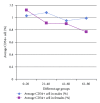Index of CD34+ Cells and Mononuclear Cells in the Bone Marrow of Spinal Cord Injury Patients of Different Age Groups: A Comparative Analysis
- PMID: 22830032
- PMCID: PMC3398573
- DOI: 10.1155/2012/787414
Index of CD34+ Cells and Mononuclear Cells in the Bone Marrow of Spinal Cord Injury Patients of Different Age Groups: A Comparative Analysis
Abstract
Introduction. Recent evidence of safety and efficacy of Bone Marrow Mononuclear Cells (BMMNC) in spinal cord injury makes the Bone Marrow (BM) CD34+ percentage and the BMMNC count gain significance. The indices of BM that change with body mass index and aging in general population have been reported but seldom in Spinal Cord Injury (SCI) victims, whose parameters of relevance differ from general population. Herein, we report the indices of BMMNC in SCI victims. Materials and Methods. BMMNCs of 332 SCI patients were isolated under GMP protocols. Cell count by Trypan blue method and CD34+ cells by flow cytometry were documented and analysed across ages and gender. Results. The average BMMNC per ml in the age groups 0-20, 21-40, 41-60, and 61-80 years were 4.71, 4.03, 3.67, and 3.02 million and the CD34+ were 1.05%, 1.04%, 0.94%, and 0.93% respectively. The decline in CD34+ was sharp between 20-40 and 40-60 age groups. Females of reproductive age group had lesser CD34+. Conclusion. The BMMNC and CD34+ percentages decline with aging in SCI victims. Their lower values in females during reproductive age should be analysed for relevance to hormonal influence. This study offers reference values of BMMNC and CD34+ of SCI victims for successful clinical application.
Figures




Similar articles
-
Bone Marrow-Derived Mononuclear Cells in the Treatment of Neurological Diseases: Knowns and Unknowns.Cell Mol Neurobiol. 2023 Oct;43(7):3211-3250. doi: 10.1007/s10571-023-01377-x. Epub 2023 Jun 25. Cell Mol Neurobiol. 2023. PMID: 37356043 Free PMC article. Review.
-
[EPOR and TPOR expressions on CD34+ CD59- and CD34+ CD59+ bone marrow cells from patients with paroxysmal nocturnal hemoglobinuria].Zhonghua Xue Ye Xue Za Zhi. 2011 Aug;32(8):543-7. Zhonghua Xue Ye Xue Za Zhi. 2011. PMID: 22338178 Chinese.
-
[The response of bone marrow hematopoietic cells to G-CSF in paroxysmal nocturnal hemoglobinuria patients].Zhonghua Xue Ye Xue Za Zhi. 2005 Apr;26(4):235-8. Zhonghua Xue Ye Xue Za Zhi. 2005. PMID: 15949269 Chinese.
-
Increased generation of pre-plasmacytoid dendritic cells in bone marrow of rheumatoid arthritis.Mod Rheumatol. 2014 May;24(3):443-7. doi: 10.3109/14397595.2013.843759. Epub 2013 Nov 5. Mod Rheumatol. 2014. PMID: 24252037
-
Characterization of hematopoietic stem cells.Ann N Y Acad Sci. 1995 Dec 29;770:42-52. doi: 10.1111/j.1749-6632.1995.tb31042.x. Ann N Y Acad Sci. 1995. PMID: 8597381 Review.
Cited by
-
Establishment of reference values based on influential characteristics of hematopoietic stem cells and immune cell subsets in the bone marrow.Heliyon. 2024 May 8;10(9):e30888. doi: 10.1016/j.heliyon.2024.e30888. eCollection 2024 May 15. Heliyon. 2024. PMID: 38774070 Free PMC article.
-
Stochastic Hypothesis of Transition from Inborn Neutropenia to AML: Interactions of Cell Population Dynamics and Population Genetics.Front Oncol. 2013 Apr 29;3:89. doi: 10.3389/fonc.2013.00089. eCollection 2013. Front Oncol. 2013. PMID: 23641360 Free PMC article.
-
Bone Marrow as a Hematopoietic Stem Cell Source for Gene Therapy in Sickle Cell Disease: Evidence from Rhesus and SCD Patients.Hum Gene Ther Clin Dev. 2017 Sep;28(3):136-144. doi: 10.1089/humc.2017.029. Epub 2017 Apr 17. Hum Gene Ther Clin Dev. 2017. PMID: 28447889 Free PMC article.
-
Bone Marrow-Derived Mononuclear Cells in the Treatment of Neurological Diseases: Knowns and Unknowns.Cell Mol Neurobiol. 2023 Oct;43(7):3211-3250. doi: 10.1007/s10571-023-01377-x. Epub 2023 Jun 25. Cell Mol Neurobiol. 2023. PMID: 37356043 Free PMC article. Review.
-
Sex-Based Differences in Autologous Cell Therapy Trials in Patients With Acute Myocardial Infarction: Subanalysis of the ACCRUE Database.Front Cardiovasc Med. 2021 May 26;8:664277. doi: 10.3389/fcvm.2021.664277. eCollection 2021. Front Cardiovasc Med. 2021. PMID: 34124198 Free PMC article.
References
-
- Cripps RA, Lee BB, Wing P, Weerts E, MacKay J, Brown D. A global map for traumatic spinal cord injury epidemiology: towards a living data repository for injury prevention. Spinal Cord. 2011;49(4):493–501. - PubMed
-
- McDonald JW, Sadowsky C. Spinal-cord injury. The Lancet. 2002;359(9304):417–425. - PubMed
-
- Sharma A, Gokulchandran N, Chopra G, et al. Administration of autologous bone marrow-derived mononuclear cells in children with incurable neurological disorders and injury is safe and improves their quality of life. Cell Transplantation. 2012;21(supplement 1):S79–S90. - PubMed
-
- Samdani AF, Paul C, Betz RR, Fischer I, Neuhuber B. Transplantation of human marrow stromal cells and mono-nuclear bone marrow cells into the injured spinal cord: a comparative study. Spine. 2009;34(24):2605–2612. - PubMed
-
- Syková E, Homola A, Mazanec R, et al. Autologous bone marrow transplantation in patients with subacute and chronic spinal cord injury. Cell Transplantation. 2006;15(8-9):675–687. - PubMed
LinkOut - more resources
Full Text Sources

